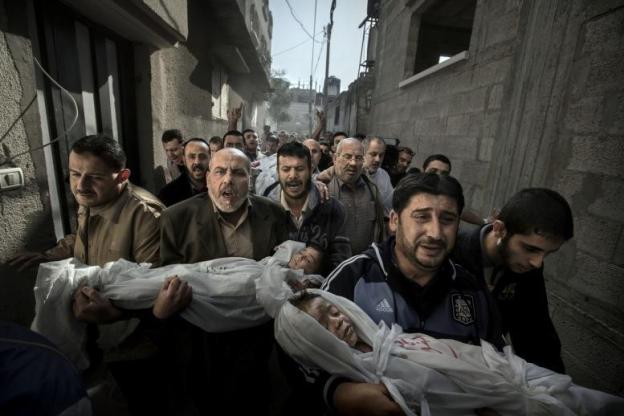
Update: Despite its own investigation validating the authenticity of photographer Paul Hansen’s controversial 2013 Photo of the Year, the experts did find that a fair amount of post-processing was done to the photo – such as darkening and lightening of areas. This and the problems stemming from the accusation of photo manipulation were enough to make the World Press Photo reevaluate its rules surrounding image post-processing. The WPP will announce more details when it calls for entries later this year, but WPP chair Gary Knight said there will be a number of changes. (Via British Journal of Photography)
A powerful, emotional photo of two dead bodies – one a two-year-old boy, the other of his older brother – being carried through Gaza City in the Palestinian Territories to their funeral was recently chosen as the 2013 World Press Photo of the Year. The two boys were killed in an Israeli airstrike last November 14, which also killed their father and injured the rest of their family. The photo, “Gaza Burial,” was taken by photojournalist Paul Hansen for the Swedish daily, Dagens Nyheter, and shows the plight of civilians caught in the middle of a conflict between Israel and Palestinian militant groups, which, according to the World Press Photo, has killed more than 150 people – 103 civilians, including at least 30 children – since a ceasefire was brokered on November 21. But a new controversy about the photo was raised, and it has nothing to do with the subject matter: A forensic image analyst says the photo has had too much Photoshop manipulation, to the point that it has been deemed fake. The speculation that the photo had been falsified caused such a commotion that the World Press Photo launched a forensic investigation into the matter, and concludes that the photo is authentic.
As Imaging Resource’s Dan Havlik reported, a forensic image analyst named Neal Krawetz, “says the winning photo includes spliced together areas of three different shots, which was done to illuminate the faces of the mourners in the picture in order to make the scene more dramatic.” Krawetz says the shadows in the photo do not line up for the time of day the photo was taken.
“The shadows from the left wall line up with a consistent sun location. The sun isn’t exactly low but maybe the reported time is wrong. At least the sky brightens in the direction of the sun. Unfortunately, the lighting on the people does not match the sun’s position. The people should have dark shadows on their right sides (photo-left), but their facial lighting does not match the available lighting,” Krawetz wrote in a post for The Hacker Factor Blog. ”So here’s what likely happened… The photographer took a series of photos. However, the sun’s position made everyone dark and in silhouette. So, he combined a few pictures and altered the people so you could see their faces.”
“The photograph by Paul Hansen, which has been selected as World Press Photo of the Year 2012 by the contest jury, has been subject to heated discussion about the level of enhancement of the image file,” the World Press Photo wrote in a statement. “Paul Hansen has previously explained in detail how he processed the image. World Press Photo has no reason to doubt his explanation. However, in order to curtail further speculation – and with full cooperation by Paul Hansen – we have asked two independent experts to carry out a forensic investigation of the image file.”
The World Press Photo has just concluded the investigation and published the independent investigators’ findings. “We have reviewed the RAW image, as supplied by World Press Photo, and the resulting published JPEG image. It is clear that the published photo was retouched with respect to both global and local color and tone. Beyond this, however, we find no evidence of significant photo manipulation or compositing. Furthermore, the analysis purporting photo manipulation is deeply flawed,” said Dr. Hany Farid, Professor of Computer Science at Dartmouth College and co-founder and CTO of Fourandsix Technologies and Kevin Connor, CEO of Fourandsix Technologies. Click here to read more of the findings.
Krawetz, however, believes he is vindicated in his claims. Read his response to the findings here.
(Image via Paul Hansen/World Press Photo)


